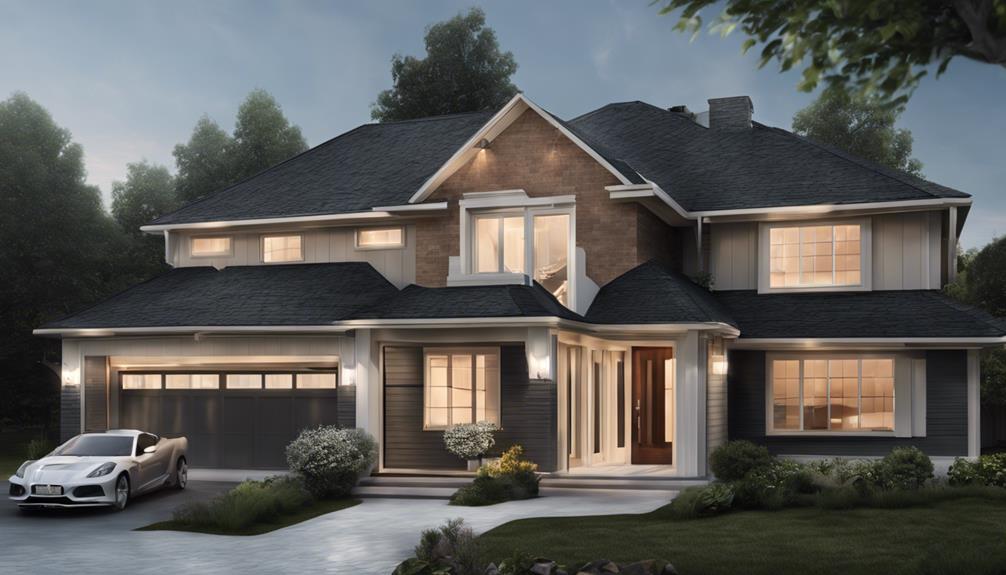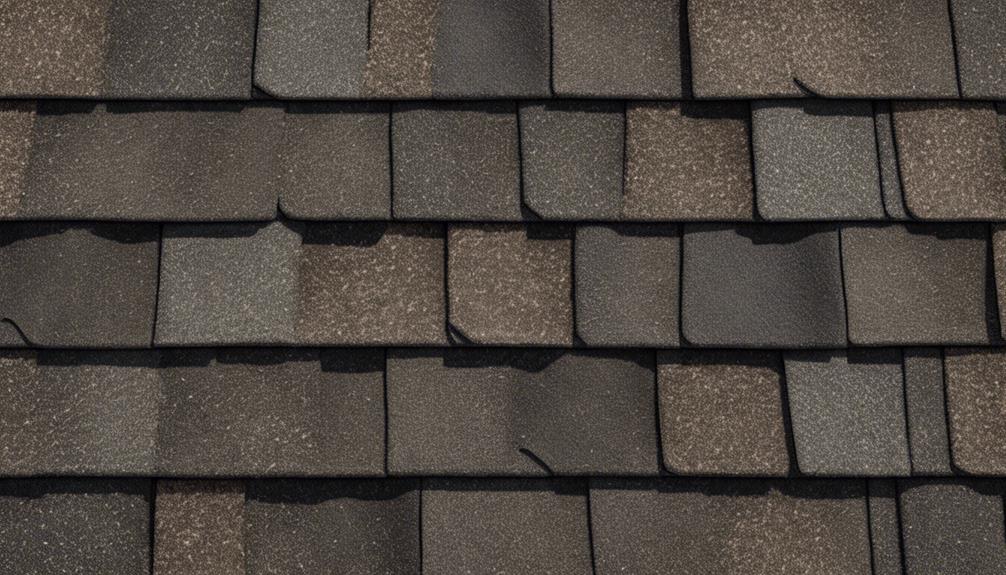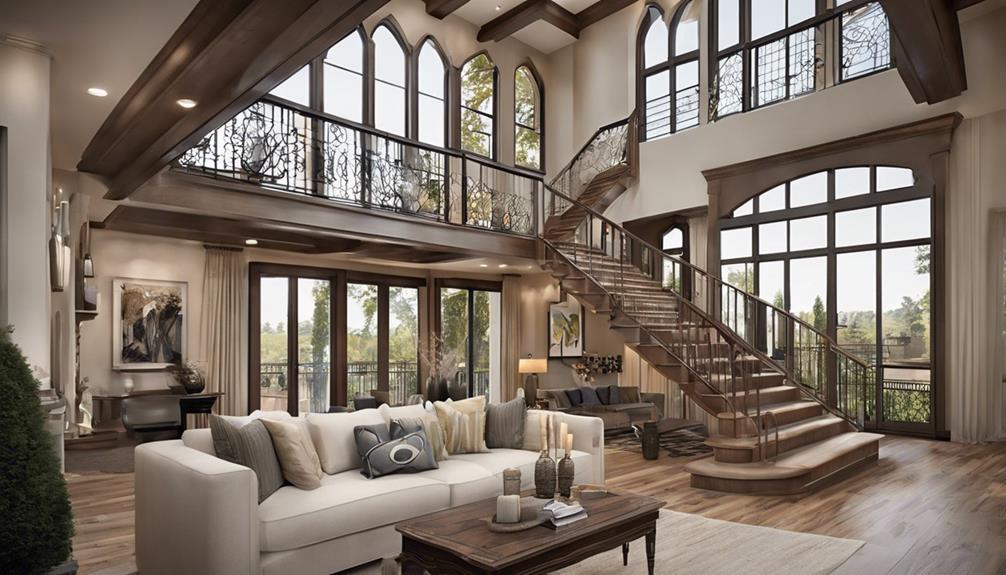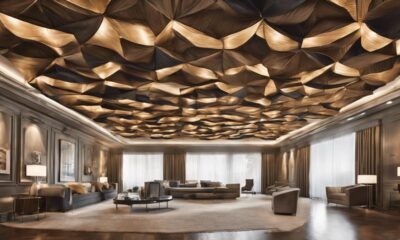Architecture Home Styles
What Makes Premium Asphalt Shingles Stand Out?
Fascinated by premium asphalt shingles? Discover the hidden performance benefits that set them apart from standard options.

When it comes to roofing materials, the distinction between standard and premium asphalt shingles is like night and day. The features that set premium asphalt shingles apart go beyond mere aesthetics. Their advanced technology features and enhanced design elements cater to homeowners seeking more than just basic protection. Superior quality materials and longevity ensure a lasting investment, but there's a key aspect that truly makes them stand out.
Curious to uncover the hidden performance benefits that elevate these shingles to the top tier?
Key Takeaways
- Advanced technology features enhance durability, wind resistance, and energy efficiency.
- Superior materials ensure longevity, impact resistance, and aesthetic appeal.
- Premium asphalt shingles offer extended warranties and potential insurance discounts.
- Proper installation and maintenance maximize lifespan, providing long-term value and cost savings.
Advanced Technology Features
Incorporating cutting-edge technology, premium asphalt shingles offer a range of advanced features that enhance durability and protection against various environmental elements. These shingles aren't your average roofing material; they're designed to withstand severe weather conditions with their impressive impact resistance. Some premium asphalt shingles come equipped with special granules that not only enhance durability but also protect against granular loss, ensuring a longer lifespan for your roof.
Moreover, advanced technology in premium asphalt shingles extends to increased wind resistance, providing added protection against strong winds that could otherwise damage a conventional roof. Additionally, certain premium asphalt shingles boast energy-saving benefits through cool roof technology. By reflecting more sunlight and absorbing less heat, these shingles contribute to overall home efficiency, reducing the strain on your cooling systems and ultimately saving you money on energy bills.
Furthermore, due to their durability and long-lasting performance, premium asphalt shingles with advanced technology features may qualify for insurance discounts. This added benefit makes them a smart and cost-effective choice for homeowners looking to protect their investment in the long run.
Enhanced Design Elements

Enhancing the overall aesthetic appeal of a roof, premium asphalt shingles feature distinctive design elements that elevate the visual sophistication of the home. These shingles boast unique contours and deep shadows, creating a sophisticated look that mimics natural materials like slate tiles or wood shakes. The Class 4 Impact Resistance ratings ensure these shingles can endure harsh weather conditions, offering long-lasting protection for your home. Additionally, the special granules embedded in premium asphalt shingles prevent discoloration over time, maintaining both the visual appeal and quality of the roof. Brands such as Crowne Slate, Armourshake, and Royal Estate excel in providing outstanding shelter and beauty, making them stand out as top-of-the-line roofing materials.
| Premium Asphalt Shingles | Enhanced Design Elements | Benefits |
|---|---|---|
| Crowne Slate | Unique contours and deep shadows | Mimics natural materials |
| Armourshake | Class 4 Impact Resistance | Long-lasting protection |
| Royal Estate | Special granules for visual appeal | Sophisticated look |
Superior Quality Materials
Premium asphalt shingles derive their exceptional durability and weather resistance from the use of superior quality materials like fiberglass matting and ceramic-coated granules. These shingles feature advanced sealants and adhesives to ensure superior weather resistance and protection against leaks. Premium asphalt shingles have specialized coatings to resist algae growth and maintain their appearance over time. Some premium shingles incorporate advanced technologies like impact resistance features to withstand harsh weather conditions. Manufacturers of premium asphalt shingles often offer extended warranties, reflecting their confidence in the quality and longevity of the product.
- The use of high-quality materials ensures longevity and durability, providing peace of mind for homeowners.
- Advanced sealants and adhesives offer superior weather resistance, protecting your home from the elements.
- Specialized coatings that resist algae growth maintain the shingles' aesthetic appeal over time.
- Incorporation of impact resistance features showcases the shingles' ability to withstand extreme weather conditions.
Longevity and Durability

Utilizing high-quality materials and advanced manufacturing techniques, premium asphalt shingles ensure exceptional longevity and durability for your roof. These shingles offer extended longevity, lasting over 30 years when correctly installed and maintained. Their increased thickness and durability provide superior wear resistance and weathering resistance compared to standard asphalt shingles.
Despite a higher initial cost of approximately $8.00 per square foot, the long-term value of premium asphalt shingles is evident through their extended lifespan. Manufacturer warranties typically cover these shingles for 30 years, guaranteeing durability and protection for your roof.
Proper installation and ventilation play crucial roles in maximizing the longevity and durability of premium asphalt shingles, safeguarding your investment for years to come. By choosing premium asphalt shingles, you ensure a reliable, long-lasting roofing solution that offers peace of mind and exceptional performance.
Performance Benefits
When considering roofing options, homeowners benefit from the outstanding performance of premium asphalt shingles. These luxury asphalt shingles not only elevate the aesthetics of a home but also offer a range of performance benefits that provide peace of mind and long-term value:
- Enhanced Impact Resistance: Premium asphalt shingles offer superior protection against hail and high winds, ensuring the safety of your home and loved ones.
- Insurance Discounts: Due to their durability in severe weather conditions, these shingles can qualify homeowners for insurance discounts, saving money in the long run.
- Longevity and Durability: With proper installation and maintenance, premium asphalt shingles provide long-term protection, ensuring the longevity of your roof.
- Class 4 Shingles: Opting for top-rated Class 4 impact-resistant shingles from reputable brands like CertainTeed, GAF, Owens Corning, Malarkey, and Atlas guarantees the highest level of performance and durability.
Regular inspections to prevent granular loss and UV damage are essential to maintaining the integrity of these premium shingles and maximizing their lifespan.
Frequently Asked Questions
Are Premium Shingles Worth It?
They're worth it. Premium asphalt shingles offer enhanced durability, longevity, and superior performance, lasting up to 30 years or more when properly maintained.
With a cost of around $8.00 per square foot for complex roofs, their high-end quality reflects their long-lasting value.
Manufacturer warranties ranging from 30 to 50 years provide comprehensive coverage, making premium asphalt shingles a smart investment for homeowners seeking superior curb appeal and reliability in their roofing materials.
What Are Premium Asphalt Shingles?
Premium asphalt shingles are top-tier roofing materials that offer enhanced durability and a luxurious aesthetic. They're larger and thicker than standard asphalt shingles, providing superior curb appeal and longevity.
These shingles typically cost around $8.00 per square foot but are worth the investment due to their premium quality. With proper installation and maintenance, they can last up to 30 years or more, making them a durable and stylish roofing option for homeowners.
What Is the Best Grade of Asphalt Shingles?
When we consider the best grade of asphalt shingles, luxury asphalt shingles often come to mind. These premium shingles stand out due to their superior quality and durability.
Thicker and larger than standard shingles, they offer enhanced longevity and curb appeal. With proper installation and maintenance, luxury asphalt shingles can last up to 30 years or more, surpassing the lifespan of other grades.
Their higher price point, around $8.00 per square foot for complex roof structures, reflects their top-tier status.
What Do Luxury Shingles Look Like?
Luxury asphalt shingles are reminiscent of natural slate, boasting a high-end appearance for roofs. Thicker and larger than standard options, they offer increased durability and a dimensional look.
Available in a variety of colors and patterns, these shingles allow for customization to match diverse architectural styles. With sharp definition and square-cut contours, luxury shingles provide a sophisticated and elegant aesthetic for upscale homes, enhancing curb appeal and property value.
Conclusion
In conclusion, premium asphalt shingles offer unmatched quality and durability for homeowners seeking long-lasting protection and aesthetic appeal. With advanced technology features and superior materials, these high-end roofing options provide a worthwhile investment in the long run.
In fact, studies have shown that premium asphalt shingles can last up to 50 years, significantly outperforming standard shingles. Consider upgrading to premium asphalt shingles for a roof that not only looks great but also stands the test of time.
- About the Author
- Latest Posts
Introducing Ron, the home decor aficionado at ByRetreat, whose passion for creating beautiful and inviting spaces is at the heart of his work. With his deep knowledge of home decor and his innate sense of style, Ron brings a wealth of expertise and a keen eye for detail to the ByRetreat team.
Ron’s love for home decor goes beyond aesthetics; he understands that our surroundings play a significant role in our overall well-being and productivity. With this in mind, Ron is dedicated to transforming remote workspaces into havens of comfort, functionality, and beauty.
Architecture Home Styles
What Elements Define Mission Style?
Get ready to uncover the essence of Mission style furniture – where form, function, and philosophy intertwine in a captivating design narrative.

When it comes to defining Mission style, the elements are more than just a mere reflection of design; they embody a philosophy.
The fusion of form and function in Mission style furniture goes beyond mere aesthetics. By exploring the origins and influences, we uncover a rich tapestry of history and craftsmanship that continues to shape contemporary interpretations.
Join us as we unravel the intricate threads that make up the fabric of Mission style, revealing a timeless tradition that continues to captivate designers and enthusiasts alike.
Key Takeaways
- Clean lines and minimal ornamentation characterize Mission style furniture.
- Natural hardwoods like Oak and Cherry are prominent in Mission furniture construction.
- Exposed joints and precise craftsmanship highlight authenticity and structural integrity.
- Warm, earthy tones and traditional finishes define the timeless appeal of Mission style.
Origins and Influences
Crafting a response to Victorian excesses and mass-produced industrial furniture, we delve into the origins and influences of Mission style elements.
The Arts and Crafts movement, spearheaded by Gustav Stickley, played a pivotal role in shaping this style. Stickley aimed to uphold the values of individual craftsmanship and authenticity, countering the dehumanization brought about by mass production.
Drawing inspiration from Shaker style, Mission furniture embodies simplicity of design and a dedication to high-quality craftsmanship. This style marked a significant shift towards the celebration of artisanal workmanship, emphasizing the uniqueness and integrity of each piece.
Key Characteristics and Features

In exploring the essence of Mission style furniture, we encounter a design philosophy rooted in simplicity, precision craftsmanship, and a profound respect for natural materials. This style is characterized by:
- Clean Lines: Mission style furniture features simple horizontal and vertical lines, often with minimal ornamentation. The design focuses on straight edges and geometric shapes, giving a sense of balance and symmetry to the pieces.
- Natural Materials: Crafted primarily from hardwoods like Oak, Cherry, Walnut, and Maple, Mission furniture highlights the beauty and durability of wood. The emphasis on natural materials reflects a connection to the earth and a desire for authenticity in craftsmanship.
- Exposed Joints: Exemplifying precision and quality craftsmanship, exposed joinery is a common feature in Mission furniture. Visible joints not only add to the aesthetic appeal but also speak to the durability and structural integrity of the pieces.
Mission style furniture's timeless appeal lies in its marriage of form and function, where every element serves a purpose, celebrating the beauty of simplicity and the artistry of the craftsman.
Materials and Construction Techniques
Utilizing high-quality hardwoods such as Oak, Cherry, Walnut, and Maple, Mission style furniture exemplifies meticulous craftsmanship and durability through exposed mortise and tenon joints. The emphasis on natural grain and the precision required in crafting these pieces is evident in the vertical and horizontal lines that define Mission style furniture. The use of quality wood not only highlights the beauty of the material but also ensures the longevity of the pieces. The construction techniques in Mission style furniture focus on exposed joints, showcasing the skill of the craftspeople and reinforcing the sturdy nature of the furniture.
In Mission style furniture, there's a deliberate lack of embellishment, allowing the simple yet elegant design to speak for itself. The durable construction methods, including block style feet, contribute to the robust appearance of the furniture while maintaining a timeless aesthetic. Additionally, the choice of leather upholstery complements the traditional styling of Mission furniture, adding a touch of sophistication and ensuring longevity in both style and durability.
Colors and Finishes

Warm, earthy tones like golden oak, rich cherry, and deep walnut finishes are prominent features in Mission style furniture, reflecting a traditional and timeless aesthetic. When it comes to colors and finishes in Mission furniture, here are some key points to consider:
- Natural Wood Grain: Popular finishes in Mission style furniture often include medium to dark stains that enhance the natural beauty of wood grains, emphasizing the vertical and horizontal lines characteristic of Mission design.
- Traditional Hues: Mission style colors lean towards warm browns, reddish tones, and dark chocolates, creating a sense of richness and depth in the furniture pieces.
- Modern Interpretations: While traditional finishes like Mission Oak highlight the natural characteristics of the wood, modern interpretations may experiment with different finishes to adapt to contemporary tastes while still maintaining the essence of Mission style's cozy and inviting ambiance.
These color choices and finishes play a crucial role in defining the classic and enduring appeal of Mission style furniture.
Evolution and Contemporary Interpretations
The evolution of Mission style furniture has seen a shift towards incorporating modern materials like metal and glass while retaining its traditional design elements. Contemporary interpretations of Mission style furniture often focus on blending solid wood with metal or glass to create a modern sensibility and aesthetic. This fusion allows for a timeless look that appeals to a wide range of individuals seeking quality pieces with durability. By highlighting grain patterns and utilizing natural grains and characteristics of the wood, these pieces showcase the elegance and spare simplicity that define Mission style. The exposed joints in modern Mission furniture add a touch of authenticity, while the crisp lines and lack of ornate details provide a sense of sophistication. Quality wood means durability to any piece, ensuring that contemporary Mission style furniture is not only visually appealing but also built to last.
| Keywords | Description |
|---|---|
| Solid Wood Furniture | Provides durability and a classic look. |
| Natural Grains and Characteristics | Highlight the beauty of wood in each piece. |
| Crisp Lines and Lack of Ornate Details | Give a sophisticated and clean appearance. |
| Elegant and Spare Simplicity | Emphasizes a refined and uncluttered design. |
| Exposed Joints and Highlighted Grain Patterns | Add authenticity and visual interest to the furniture. |
Frequently Asked Questions
What Are the Elements of Mission Style?
When we explore the essence of Mission style, we uncover a design philosophy rooted in simplicity, craftsmanship, and functionality.
The hallmark elements of this style encompass a celebration of natural wood grain, clean horizontal and vertical lines, and exposed mortise-and-tenon joints, showcasing both durability and aesthetic beauty.
These characteristics are further accentuated by block-style feet, leather seatings, and a preference for hardwoods like Oak, Cherry, Walnut, and Maple, epitomizing timeless elegance.
What Defines Mission Style?
When we consider what defines Mission style, we focus on the simplicity of horizontal and vertical lines, limited ornamentation, and the emphasis on natural wood grain and exposed joinery.
This style showcases rectangular shapes, block-style feet, and leather seats on chairs. Crafted from hardwoods like Oak, Cherry, Walnut, and Maple, Mission furniture radiates timeless elegance with exposed pegs and minimal decorative elements as its defining features.
What Makes a Mission Style House?
When we think about what makes a mission style house, we focus on the distinctive features that give it its unique charm. Elements like terracotta tile roofs, white stucco exteriors, and intricate tile accents are key in defining this architectural style.
Additionally, stained wood accents, tile floors, and stone fireplaces create a warm and inviting atmosphere inside these homes. Quatrefoil windows, cast stone columns, and ornate iron stair railings further contribute to the timeless appeal of Mission style architecture.
What Is the Difference Between Craftsman and Mission Style?
When comparing Craftsman and Mission styles, it's crucial to note their distinct design features. Craftsman pieces often showcase decorative elements and curved lines, while Mission furniture focuses on straight lines and minimal ornamentation.
Craftsman style may incorporate intricate detailing, giving it a refined look, whereas Mission style emphasizes practical functionality and exposed joinery for a simpler, sturdier aesthetic. Both styles value craftsmanship and quality materials but offer unique characteristics that cater to different tastes.
Conclusion
In conclusion, the timeless beauty and functionality of mission style furniture are evident in its simple lines, natural materials, and exquisite craftsmanship.
Just like a well-crafted piece of mission furniture, this design aesthetic stands the test of time, blending traditional charm with modern appeal.
It's like a carefully constructed puzzle, each element fitting perfectly together to create a stunning and enduring work of art that will be cherished for generations to come.
- About the Author
- Latest Posts
Introducing Ron, the home decor aficionado at ByRetreat, whose passion for creating beautiful and inviting spaces is at the heart of his work. With his deep knowledge of home decor and his innate sense of style, Ron brings a wealth of expertise and a keen eye for detail to the ByRetreat team.
Ron’s love for home decor goes beyond aesthetics; he understands that our surroundings play a significant role in our overall well-being and productivity. With this in mind, Ron is dedicated to transforming remote workspaces into havens of comfort, functionality, and beauty.
Architecture Home Styles
What Features Define a Two-Story House?
Open the door to explore the defining features of a two-story house, from its layout to design elements, offering a blend of functionality and aesthetics.

When considering the features that define a two-story house, it's essential to acknowledge the potential concern about accessibility and mobility issues. However, beyond this initial consideration, there are several key characteristics that set two-story houses apart and make them a popular choice for many homeowners.
From the layout and structural components to the design elements and advantages they offer, two-story homes present a unique blend of functionality and aesthetics that cater to diverse needs and preferences. The discussion on what truly defines a two-story house goes beyond mere physical attributes; it encompasses a lifestyle and practicality that continue to shape the appeal of these structures.
Key Takeaways
- Bedrooms on the second floor offer privacy and better views.
- Strategic division of living and sleeping spaces for efficient use.
- Lower building costs with more living space per square foot.
- Clear separation between communal areas and private retreats for balanced living.
Key Layout Characteristics
In a two-story house, the key layout characteristics focus on the strategic division of living and sleeping spaces to optimize privacy and space utilization. Bedrooms on the second floor provide a private retreat away from the hustle and bustle of the main living areas on the ground floor. The living area on the lower level serves as the central hub for daily activities, seamlessly connected to the dining area for convenience. By stacking these functions on separate floors, two-story houses make efficient use of a larger footprint, maximizing both indoor and outdoor space.
The upper level's design emphasizes natural light and clean lines, creating a modern and airy atmosphere. This floor often houses the bedrooms, ensuring a quiet and restful environment away from the more active entertainment spaces below. Two-story house plans are carefully crafted to balance functionality and aesthetics, offering a harmonious blend of privacy and communal living.
Structural Components Overview

A two-story house's structural components encompass essential elements like load-bearing walls, floor joists, and a staircase interconnecting both levels. These components are vital for the stability and functionality of the home.
When considering the structural aspects of a two-story house, several key features come into play:
- Load-Bearing Walls: These walls support the weight of the upper floors and the roof, distributing the structural load effectively.
- Floor Joists: These horizontal beams provide support for the flooring on the second level, ensuring structural integrity and stability.
- Staircase: Connecting the ground floor to the second floor, the staircase not only provides access but also plays a role in distributing weight between the levels.
- Gable Roof: Often seen in two-story houses, the gable roof design not only adds aesthetic appeal but also contributes to efficient water runoff and structural strength.
- Foundation Design: The foundation of a two-story house must be carefully planned and constructed to support the additional weight of the second floor and ensure the stability of the entire structure.
Design Elements of Two-Story Houses
Exploring the design elements of two-story houses reveals intricate planning and strategic layout considerations that contribute to the overall functionality and aesthetic appeal of these homes. Two-story homes are characterized by a traditional layout where the ground floor typically houses the entrance, living areas, and dining spaces, while the second floor is primarily designated for bedrooms. This architectural design allows for a clear separation between the living and sleeping areas, offering residents increased privacy. Additionally, the placement of bedrooms on the second floor provides better views, enhancing the overall living experience within the home.
The design of two-story houses is carefully crafted to optimize space and create a harmonious flow between different areas of the home. By strategically arranging living spaces on the first floor and bedrooms on the second floor, these homes offer a balance between communal areas and private retreats. This thoughtful layout not only maximizes functionality but also contributes to the unique charm and appeal of two-story houses.
Advantages of Two-Story Homes

With lower building costs compared to one-story homes, two-story homes offer various advantages that appeal to homeowners seeking space efficiency and privacy. In addition to cost savings, two-story homes provide more living space per square foot of land due to their vertical design. The upper floor typically houses bedrooms, offering privacy and separation from the common areas on the first level. This layout allows for an open floor plan on the first level, creating a spacious and interconnected living area. Two-story homes also maximize outdoor space, offering better views from elevated levels.
- More living space
- Enhanced privacy with bedrooms on the upper floor
- Open floor plan on the first level
- Better utilization of outdoor space
- Flexibility in room arrangements and layouts
Furthermore, two-story homes present opportunities for design options such as incorporating a guest suite or a home office on the second floor. The smaller footprint of a two-story home allows for potential expansion in various areas to accommodate changing needs.
Considerations When Choosing a Two-Story House
Considering a two-story house requires thoughtful evaluation of its privacy benefits, safety considerations, building costs, and maintenance implications.
One of the main advantages when it comes to choosing a two-story house is the increased privacy that the upper floor offers, providing better views and separation from the outside world. However, it's crucial to weigh the potential safety issues, longer build time, and the need for stairs in a two-story home, especially if you have small children.
While two-story houses generally have lower building costs and require less foundation, they come with the trade-off of less usable square footage on the first floor. Maintenance implications should also be considered; a two-story house may require more effort to upkeep compared to a one-story home.
Ultimately, when deciding between a one-story or a two-story house, it's essential to balance the pros and cons to find a home that suits your lifestyle and preferences.
Frequently Asked Questions
What Qualifies as a 2-Story House?
We define a two-story house as a dwelling with two full floors, often with bedrooms on the second floor. The ground level typically encompasses the entrance, living, and dining areas. This design offers more space and privacy.
What Are the Features of a Two Story House?
We'll delve into the features of a two-story house, highlighting its distinct levels, offering privacy and space. Staircases connecting living and sleeping areas add architectural charm. Enhanced views, separation of functions, and a cozy feel are hallmarks.
What Is a Typical 2-Story House?
We find a typical 2-story house to be a dwelling with two levels, the ground floor for common areas and the second floor designated for bedrooms. This layout provides separation between living and sleeping spaces, offering more privacy and better views.
What Is the Definition of a Two Story Building?
We see a two-story building as a vertical canvas, where each floor serves a distinct purpose. The ground floor hosts daily activities, while the second floor offers privacy and rest. Stairs or an elevator connect these levels, maximizing space efficiency.
Conclusion
In conclusion, two-story houses offer a spacious layout, privacy, and a better view from the second floor.
While some may have concerns about accessibility for individuals with mobility issues, modern designs incorporate features like elevators or chairlifts to address these challenges.
The benefits of ample living space and separate sleeping areas outweigh the potential limitations, making two-story homes a desirable option for many families.
- About the Author
- Latest Posts
Introducing Ron, the home decor aficionado at ByRetreat, whose passion for creating beautiful and inviting spaces is at the heart of his work. With his deep knowledge of home decor and his innate sense of style, Ron brings a wealth of expertise and a keen eye for detail to the ByRetreat team.
Ron’s love for home decor goes beyond aesthetics; he understands that our surroundings play a significant role in our overall well-being and productivity. With this in mind, Ron is dedicated to transforming remote workspaces into havens of comfort, functionality, and beauty.
Architecture Home Styles
Top 3 Most Durable Wood Flooring Types
Marvel at the durability and beauty of oak, bamboo, and Brazilian walnut wood flooring types—discover which one reigns supreme for lasting elegance!

When it comes to choosing wood flooring that will last a long time, we are typically attracted to three main options. Each one offers its own unique qualities and charm.
From the timeless oak to the surprisingly resilient bamboo and the exotic Brazilian walnut, also known as Ipe, these top players in the wood flooring arena have much to offer.
But what sets them apart in terms of durability and longevity? Let's explore the nuances that make them the top choices for lasting beauty and functionality in our living spaces.
Key Takeaways
- Oak and hickory are top choices for durable wood flooring due to high Janka hardness ratings.
- Santos Mahogany offers exceptional strength and elegance, ideal for high-traffic areas.
- Bamboo's resilience and eco-friendliness make it a popular and durable flooring option.
- Brazilian Walnut (Ipe) stands out for its extreme durability, rich colors, and resistance to wear.
Oak: The Industry Standard
When it comes to durable wood flooring types, oak stands out as the industry standard due to its exceptional strength and resilience against wear and tear. Oak boasts a high Janka hardness rating, making it highly durable and resistant to dents and scratches. This makes it an ideal choice for high-traffic areas in homes or commercial spaces where longevity is crucial. Red oak and white oak are two common species used for oak flooring, both known for their durability and classic aesthetic appeal.
Oak wood flooring offers a range of finishes and colors, providing versatility in design options while maintaining its robust nature. Its timeless and classic appearance not only adds value to a home but also ensures that the flooring will withstand the test of time. Whether you prefer the warm tones of red oak or the subtle beauty of white oak, choosing oak flooring guarantees a durable and elegant solution for your space.
Hickory: The Hardest American Wood Species

Renowned for its exceptional durability and unmatched strength, hickory emerges as the hardest American wood species, boasting a remarkable Janka hardness rating.
With a high Janka rating ranging from 1820 to 2200, hickory stands out as a top choice for durable flooring options. Its superior resilience against dents and scratches makes it ideal for high-traffic areas like kitchens and living rooms.
Hickory's distinct grain patterns and color variations not only enhance its durability but also add a touch of rustic charm and character to any space. Homeowners favor hickory wood flooring for its timeless aesthetic and long-lasting quality, ensuring that their floors remain both stylish and resilient for years to come.
When seeking a flooring option that combines strength, scratch resistance, and a visually appealing look, hickory proves to be a reliable and enduring choice.
Santos Mahogany: An Exotic and Durable Wood
Emerging as another top contender in the realm of durable wood flooring options is Santos Mahogany, an exotic wood species prized for its exceptional strength and longevity. With its high Janka rating and remarkable hardness, Santos Mahogany stands out as a durable choice for flooring that can withstand the rigors of high-traffic areas. The wood's rich, deep reddish-brown color exudes luxury and adds a touch of elegance and warmth to any space.
Homeowners seeking a premium and long-lasting flooring option often turn to Santos Mahogany for its durability and low-maintenance qualities. This exotic wood not only offers a stunning aesthetic but also provides a practical solution for those looking for a reliable and resilient flooring choice. Whether in residential or commercial settings, Santos Mahogany proves to be a wise investment, combining beauty with functionality in a way that few other flooring options can match. For those desiring a luxurious yet practical flooring solution, Santos Mahogany stands as a top-tier choice.
Frequently Asked Questions
What Type of Wood Flooring Is the Most Durable?
We believe the most durable wood flooring is Brazilian Walnut, known for its high Janka hardness scale rating of 3684. This hardwood option offers exceptional durability and longevity due to its robust nature.
Additionally, Brazilian Walnut is highly resistant to scratches and dents, making it an ideal choice for areas with high foot traffic or potential impact. Its durability makes it a top choice for long-lasting flooring solutions.
What Is the Best Hardwearing Wood Flooring?
When it comes to hardwearing wood flooring, the best choice is often determined by factors like durability, resistance to wear and tear, and maintenance requirements.
Several wood types stand out for their ability to withstand heavy use and maintain their appearance over time.
Consider factors like Janka rating, scratch resistance, and dent resistance when selecting the best hardwearing wood flooring for your space.
What Is the Best Scratch Resistant Hardwood Flooring?
When it comes to finding scratch-resistant hardwood flooring, look no further than Dogwood®. With its innovative densified natural wood and Cleantivity™ antimicrobial coating, Dogwood stands out for its exceptional durability and resistance to scratches.
Brazilian Walnut, boasting a high Janka rating, is another top contender for scratch-resistant hardwood floors. Combining these options with hickory and white oak, Dogwood engineered hardwood offers a winning choice for long-lasting, tough flooring solutions.
What Is the Hardest Wearing Hardwood Floor?
When considering the hardest wearing hardwood floor, it's essential to focus on the Janka hardness rating of the wood species. Brazilian Walnut leads with a Janka rating of 3684, indicating exceptional durability.
Brazilian Cherry follows closely with a rating of 2350, making it a robust option.
Additionally, domestic species like hickory, maple, and white oak offer high durability for hardwood flooring. These choices are excellent for long-lasting and sturdy flooring solutions.
Conclusion
In conclusion, when it comes to choosing the most durable wood flooring types, oak, bamboo, and Brazilian walnut (Ipe) stand out as top contenders. Their strength, resilience, and elegance make them ideal choices for high-traffic areas and spaces that require long-lasting flooring solutions.
For example, a luxury hotel in a bustling city opted for Brazilian walnut flooring in their lobby, withstanding heavy foot traffic and maintaining its beauty for years to come.
Choose durability and style with these top wood flooring options.
- About the Author
- Latest Posts
Introducing Ron, the home decor aficionado at ByRetreat, whose passion for creating beautiful and inviting spaces is at the heart of his work. With his deep knowledge of home decor and his innate sense of style, Ron brings a wealth of expertise and a keen eye for detail to the ByRetreat team.
Ron’s love for home decor goes beyond aesthetics; he understands that our surroundings play a significant role in our overall well-being and productivity. With this in mind, Ron is dedicated to transforming remote workspaces into havens of comfort, functionality, and beauty.
-

 Vetted1 week ago
Vetted1 week ago15 Best Tile Adhesives for Outdoor Use – Top Picks for Durable and Weather-Resistant Installations
-

 Beginners Guides4 days ago
Beginners Guides4 days agoDesigning Your Retreat Center – Essential Tips
-

 Beginners Guides6 days ago
Beginners Guides6 days agoAre Retreats Profitable
-

 Vetted7 days ago
Vetted7 days ago15 Creative Ways to Cover Up Popcorn Ceilings and Transform Your Space
-

 Vetted6 days ago
Vetted6 days ago15 Best Playroom Storage Solutions to Keep Your Kids' Space Organized and Fun
-

 Vetted3 weeks ago
Vetted3 weeks ago15 Best Ways to Label Clothes for Nursing Home Residents – Stay Organized and Efficient
-

 Vetted1 week ago
Vetted1 week ago15 Best Plants to Thrive on the North Side of Your House – A Gardener's Guide
-

 Vetted2 weeks ago
Vetted2 weeks ago15 Best Boxwood Varieties for Thriving in Full Sunlight




























